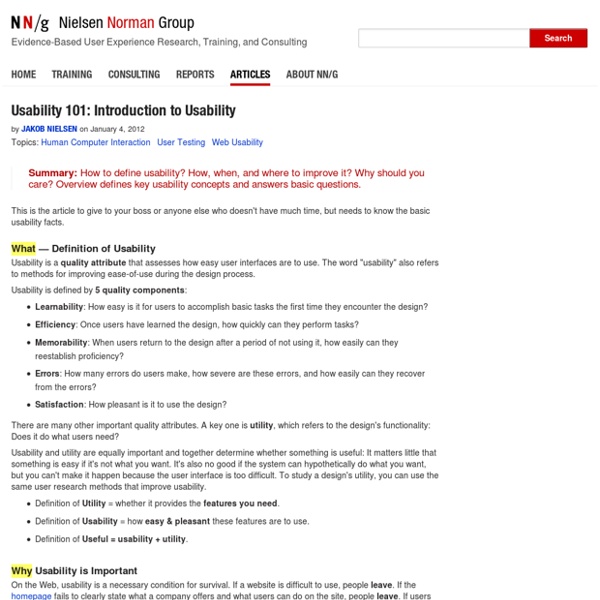



Widgets “You are Here” indicator a way of indicating the current location (or view area) when looking at an overview map, site map, navigation bar, etc. The indicator can be as simple as a dot, a bounding rectangle, an arrow, or a hilited item. “You… Read more » about box A dialog box that describes the software product as a whole and the company that created it. Read more » accumulating attribute group a set of items or properties that are related and whose effect is cumulative, as with a group of checkboxes. Read more » adaptive menu a menu where the most recently-selected item(s) are shown at the top so as to help the user repeat common commands quickly without searching for them in long menus. Read more » adaptive palette a tool palette or toolbar that allows tools to be selected from a pop-up menu, and then shows the chosen tool as the default tool for that menu (can be selected again just by clicking, without the menu appearing). Read more » adornment Read more » alert box Read more » assistant / wizard
A Brief History Of User Experience Design Think about the last time you ate at a restaurant. What cuisine did it serve? What made you to choose that particular restaurant? Your answers to these questions, including all the emotional highs and lows, encompass the restaurant’s user experience (UX). However, when people use the term UX, they’re usually referring to one’s experience with a digital or technological product or service. Today, UX has grown into an important design discipline that continues to grow and evolve. To think about where the much debated-practice of user experience design will take us next, it’ll help to take a look back at some of the key events in its meandering evolution. Circa 1430: Leonardo da Vinci’s "kitchen nightmare"Michael Gelb’s wonderful book How to Think Like Leonardo da Vinci: Seven Steps To Genius Every Day recounts the story of the Duke of Milan commissioning da Vinci to design the kitchen for a high-profile feast. In it, he writes:
Ergonomie informatique La clé de la réussite d'un projet informatique n'est pas seulement technique. La démarche ergonomique vise à intégrer la composante humaine, le "point de vue utilisateur", dans le processus de conception d'un produit informatique. L'ergonomie informatique permet de réduire les coûts de développement en simulant dés le début du projet la façon dont le logiciel sera réellement utilisé. Les principales méthodes L'approche ergonomique s'appuie sur un processus itératif, c'est à dire des phases d'évaluation et d'amélioration du produit. L'audit ergonomique consiste à vérifier si le logiciel respecte un ensemble de critères d'utilisabilité. Ces outils permettent d'identifier les problèmes d'utilisabilité d'un logiciel ou d'un site web et ainsi d'en améliorer la qualité ergonomique. D'autres méthodes sont employées lors du développement afin de garantir l'adéquation avec l'activité de l'utilisateur : Enjeux de l'ergonomie en informatique Bien entendu, la démarche ergonomique a également un coût.
Data collection for usability research Taking notes in usability tests Anyone who has ever conducted a usability evaluation of a web site, software application, or consumer product, knows that human behaviour research often produces reams of data that can take significant time to analyse. To be productive, researchers must organize and reduce these data so that they can quickly perform their analysis and proceed with improving the product. People who are new to the field tend to take notes on paper or on a computer. Unfortunately, this approach can make data compilation cumbersome. How to define behaviours and collect data in usability tests Before entering into a discussion on logging the data that arises from usability research, let's review some terminology associated with usability research. The ISO Definition of usability: Effectiveness, Efficiency, and Satisfaction Distinguishing Quantitative/Qualitative and Objective/Subjective Data Distinguishing between Formative and Summative Evaluations Datalogging Practices Bit Debris
Affordances The concept of an affordance was coined by the perceptual psychologist James J. Gibson in his seminal book The Ecological Approach to Visual Perception. The concept was introduced to the HCI community by Donald Norman in his book The Psychology of Everyday Things from 1988. There has however been ambiguity in Norman's use of the concept, and the concept thus requires a more elaborate explanation. Norman's use of the term According to Norman (1988) an affordance is the design aspect of an object which suggest how the object should be used; a visual clue to its function and use. "...the term affordance refers to the perceived and actual properties of the thing, primarily those fundamental properties that determine just how the thing could possibly be used. [...] Norman thus defines an affordance as something of both actual and perceived properties. Gibson's use of the term An affordance according to Gibson exists relative to the action capabilities of particular actors. Open Access License
5 Signs of a Great User Experience If you’ve used the mobile social network Path recently, it’s likely that you enjoyed the experience. Path has a sophisticated design, yet it’s easy to use. It sports an attractive red color scheme and the navigation is smooth as silk. In short, Path has a great user experience. 1. A great user experience isn’t just about the user interface, but it helps a lot. 2. A nice design is one thing, but you also need to see value in it. 3. The Kindle Fire as a product is not as aesthetically pleasing as the iPad 2. Note that the rest of the Kindle Fire’s user experience is not always pleasurable. 4. With so many Internet-connected devices and screens nowadays, it’s important to have a consistent experience. 5. Arguably the most outstanding tech products are ones that revolutionize the way we do things. When I asked for examples of a great user experience over on Google+, Chris Brogan commented that FitBit has changed the way he manages his fitness.